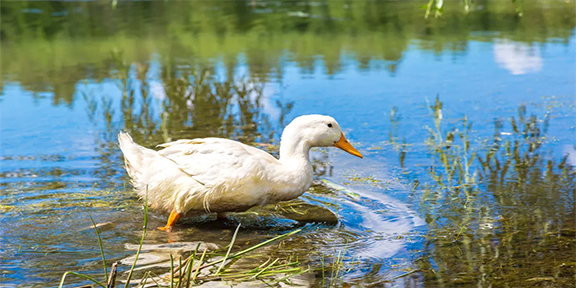Man and animal, it’s an ancient combination. We observe them. We marvel at them. We capture them. On occasion they capture us. We train them to be our eyes and ears. We work them and pamper them. We befriend them, care for them and love them. We breed them, adopt them and share our lives with them. We sometimes eat them and sometimes they eat us. Sometimes we even learn something from them.
Bonding with an animal, be it canine, feline, bovine or reptilian, teaches us something about ourselves. Bonding with a pup is easy. Bonding with a feathered friend is more challenging but not impossible. I’ve always heard that hatchlings bond with the first image they see. Fortunately this is usually mom. One Easter several years ago I set out on a path that revealed the true depth of animal bonding. I became mom to a three-week-old duck.
I lived on a farm. One more animal didn’t seem like much. I bought two ducks from a store selling chicks and ducks at Easter (a practice now outlawed, fortunately). Wanting to rescue nearly one hundred ducks, I came to my senses and saved only two. One died the first night and I felt even worse for the remaining fuzz ball with a bill.
The nurturing side of me went into hyper drive and I was determined that this lone duck would lead a fairy tale life. With the help of a heating pad under a straw nest she (I was never really sure of duck gender) survived the first month or so. I held her often and named her Tulip in honor of the nearly one hundred tulips that were blooming in my garden. I was really hoping the other ducklings I’d left in the store were all blooming as well.
Tulip bonded all right. She waddled after me all day, looking me up and down regularly to make sure she was doing everything just right. If I sat on the porch she would sit down next to me, looking up as if to say “Are we just going to sit here? Am I doing it right?” Tulip was as human as she could be. She was a human-duck.
When her fuzz gave way to feathers I walked her down to the pond. I assumed ducks could and would swim. But when I sat on the edge of the pond, Tulip sat on the edge of the pond. I pushed her in only to find her paddling back to be next to me. No dice. I rolled up my pants and waded in, followed by the fuzz ball.
Others had dogs and cats for pets. A few had a horse or a goat—this was the country, after all. I had a pet duck. We took walks, went swimming, ate blackberries and grubs (I passed on the grubs) and worked in the garden. As to the latter, I worked in the garden. Tulip observed and mimicked my every move. She stayed within three feet of me and tried to figure out her role in this bizarre activity. It wasn’t quite working. I pulled weeds while she ate the lettuce. I mounded the dirt on the potatoes while she spread the dirt out with her webbed feet.
When I wasn’t available Tulip tended to follow (very closely) our large Labrador retriever. I don’t think she ever achieved dog-duck though. Four legs are faster than two, and he snarled at her a few times for sticking too close. A duck in tow was not good for his guard dog image.
It was about this time that I decided perhaps I wasn’t the best imprint for a duck. Maybe she should live with the chickens. At least they had feathers and similar body parts. As I walked away from the hen house, I looked back to see her running up and down the thirty feet of pen, flapping wings, jumping, and squawking at my departure. Two weeks later Tulip was a chicken-duck.
I entered the hen house to collect eggs and found a row of eleven nests occupied by egg-laying hens. They always look so stoic when they’re laying. Nestled in, looking forward in polite propriety. If they had thumbs they’d be knitting. On the last nest sat Tulip. Now for all I know she was a he, and laying an egg wasn’t even a remote possibility. As I entered, all heads turned to inspect the rude intruder. Chickens don’t like it when you reach under them to gather an egg or two for breakfast. It’s the ultimate indignity. Tulip jumped and quacked, nesting down again only when the other hens stared her down for such an outburst. She leaned forward and looked up and down the row of nests and back at me. “Am I doing this right? Am I? I’m doing as the other chickens do.” Her look said it all.
Thus was the life of Tulip the chicken-duck. She scratched the dirt, even with webbed feet. She foraged with the chickens in the nearby woods for treats. Pecking in the dirt was difficult with a rounded bill but she made all the appropriate motions. I still took her to the pond occasionally for swimming and filtering the mud for snacks. The one chicken skill she never quite mastered was perching. Web feet just don’t wrap around a branch like chicken toes do. Much to the chickens disapproval, she tended to sleep in the nests.
I sometimes wondered if I’d really done Tulip a favor by bringing her to this menagerie of non-ducks. She spent a lifetime trying to be something she wasn’t. She tried to identify with something, someone, anything. A lifetime trying to bond. I was pleased to share Tulip’s path in life. I learned to appreciate the work it takes to fit in.
Ultimately, the fairy tale life I had so wanted for Tulip did not quite work out. She tried to be human, tried to be a dog, tried to be a chicken, died trying. She and five of her feathered roommates were eaten by a wolf while foraging in the nearby forest. I tried to save Tulip and did for a time. In the end, I learned something about the limits of bonding.

